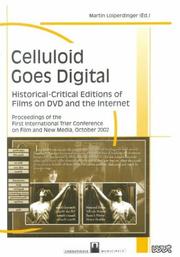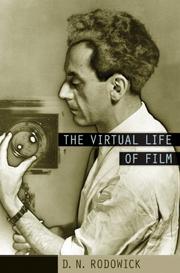| Listing 1 - 9 of 9 |
Sort by
|
Book
ISBN: 9780240811376 0240811372 9781136137747 9781136137693 9781136137730 9781138400603 Year: 2009 Publisher: Amsterdam : Focal Press/Elsevier,
Abstract | Keywords | Export | Availability | Bookmark
 Loading...
Loading...Choose an application
- Reference Manager
- EndNote
- RefWorks (Direct export to RefWorks)
3-D films. --- Digital cinematography. --- Cinéma en relief --- Cinéma numérique --- Cinéma en relief --- Cinéma numérique

ISBN: 3884765981 Year: 2003 Volume: Bd. 12 Publisher: Trier : WVT, Wissenschaftlicher Verlag Trier,
Abstract | Keywords | Export | Availability | Bookmark
 Loading...
Loading...Choose an application
- Reference Manager
- EndNote
- RefWorks (Direct export to RefWorks)
Digital cinematography --- Digital video --- Motion picture film --- Cinéma numérique --- Vidéo numérique --- Films (Pellicules cinématographiques) --- Congresses. --- Conservation and restoration --- Congrès --- Conservation et restauration --- Preservation --- Cinéma numérique --- Vidéo numérique --- Films (Pellicules cinématographiques) --- Congrès
Book
ISBN: 9780231178938 023117893X 9780231178921 0231178921 9780231850971 0231850972 Year: 2016 Publisher: London Wallflower Press
Abstract | Keywords | Export | Availability | Bookmark
 Loading...
Loading...Choose an application
- Reference Manager
- EndNote
- RefWorks (Direct export to RefWorks)
Cinema, the primary vehicle for storytelling in the twentieth century, is being reconfigured by new media in the twenty-first. Terms such as "worldbuilding, " "virtual reality, " and "transmedia" introduce new methods for constructing a screenplay and experiencing and sharing a story. Similarly, 3D cinematography, hypercinema, and visual effects require different modes for composing an image, and virtual technology, motion capture, and previsualization completely rearrange the traditional flow of cinematic production. What does this mean for telling stories? Fast Forward answers this question by investigating a full range of contemporary creative practices dedicated to the future of mediated storytelling and by connecting with a new generation of filmmakers, screenwriters, technologists, media artists, and designers to discover how they work now, and toward what end. From Chris Milk and Aaron Koblin's exploration of VR spherical filmmaking to Rebeca Méndez's projection and installation work exploring climate change to the richly mediated interactive live performances of the collective Cloud Eye Control, this volume captures a moment of creative evolution and sets the stage for imagining the future of the cinematic arts.
Digital cinematography. --- Motion pictures and television. --- Mass media and language. --- Motion picture industry. --- Cinéma numérique --- Cinéma et télévision --- Médias et langage --- Cinéma --- Industrie --- Vidéo --- Digital video --- Digital cinematography --- Experimental films --- Technique --- Cinéma numérique --- Cinéma et télévision --- Médias et langage --- Cinéma --- Film --- Cinéma numérique. --- Vidéo. --- Technique.

ISBN: 9780674026681 0674026683 9780674026988 0674026985 0674042832 9780674042834 0674266773 Year: 2007 Publisher: Cambridge, Mass. : Harvard University Press,
Abstract | Keywords | Export | Availability | Bookmark
 Loading...
Loading...Choose an application
- Reference Manager
- EndNote
- RefWorks (Direct export to RefWorks)
As almost every aspect of making and viewing movies is replaced by digital technologies, even the notion of "watching a film" is fast becoming an anachronism. With the likely disappearance of celluloid film stock as a medium, and the emergence of new media, what will happen to cinema--and to cinema studies? In the first of two books exploring this question, Rodowick considers the fate of film and its role in the aesthetics and culture of the twenty-first century.
Digital cinematography. --- Photography --- Digital techniques. --- Cinéma numérique --- Photographie numérique --- Et le cinéma --- Film --- Aesthetics --- film --- digitale film --- filmtechniek --- digitale cultuur --- nieuwe media --- technologie --- filmheorie --- 791.41 --- Cinematography --- Digital filmmaking --- Digital moviemaking --- Digital photography --- Digital techniques --- Digital electronics --- Cinéma numérique. --- Et le cinéma. --- Digital cinematography --- Cinéma numérique. --- Photographie numérique --- Et le cinéma.
Book
ISBN: 9780748646890 9780748646906 0748646892 0748646906 9780748646913 0748646914 9780748675623 0748675620 9780748675616 0748675612 9781299105782 1299105785 Year: 2022 Publisher: Edinburgh
Abstract | Keywords | Export | Availability | Bookmark
 Loading...
Loading...Choose an application
- Reference Manager
- EndNote
- RefWorks (Direct export to RefWorks)
Explores how film analysis can take account of the presence of digital images in cinemaDigital images are now ubiquitous elements within the cinematic frame but, as we analyse films or film moments, it can often be difficult to be sure how - and how much - to talk about digital elements. This accessible book demystifies the relationship of digital imaging to processes of watching and reading films, and gives scholars and students the tools to engage with digital imaging in cinema with ease. A wide-ranging series of case studies demonstrates how digital elements can be discussed and analysed in
Digital cinematography --- Cinematography --- Motion pictures --- Cinéma numérique --- Cinéma --- Films --- History --- Production and direction --- Special effects --- Evaluation. --- Histoire --- Production et réalisation --- Effets spéciaux --- Evaluation --- Digital cinematography. --- Photography --- Chronophotography --- Digital filmmaking --- Digital moviemaking --- Technological innovations. --- Animated pictures --- Digital techniques
Book
ISBN: 1784026697 1283864541 0813552184 9780813552187 9780813551852 0813551854 9780813551869 0813551862 9781784026691 9781283864541 Year: 2012 Publisher: New Brunswick, N.J. : Rutgers University Press,
Abstract | Keywords | Export | Availability | Bookmark
 Loading...
Loading...Choose an application
- Reference Manager
- EndNote
- RefWorks (Direct export to RefWorks)
Avatar. Inception. Jurassic Park. Lord of the Rings. Ratatouille. Not only are these some of the highest-grossing films of all time, they are also prime examples of how digital visual effects have transformed Hollywood filmmaking. Some critics, however, fear that this digital revolution marks a radical break with cinematic tradition, heralding the death of serious realistic movies in favor of computer-generated pure spectacle. Digital Visual Effects in Cinema counters this alarmist reading, by showing how digital effects?driven films should be understood as a continuation of the narrative and stylistic traditions that have defined American cinema for decades. Stephen Prince argues for an understanding of digital technologies as an expanded toolbox, available to enhance both realist films and cinematic fantasies. He offers a detailed exploration of each of these tools, from lighting technologies to image capture to stereoscopic 3D. Integrating aesthetic, historical, and theoretical analyses of digital visual effects, Digital Visual Effects in Cinema is an essential guide for understanding movie-making today.
Cinematography --- Digital cinematography. --- Motion pictures --- Motion picture industry --- Photography --- Chronophotography --- Special effects (Cinematography) --- Trick cinematography --- Digital filmmaking --- Digital moviemaking --- Aesthetics --- Film industry (Motion pictures) --- Moving-picture industry --- Cultural industries --- Technological innovations. --- Special effects. --- Aesthetics. --- Animated pictures --- Special effects --- Digital techniques --- Cinéma --- Cinéma numérique --- Industrie --- Innovations --- Esthétique --- Effets spéciaux
Book
ISBN: 9781782389019 1782389016 0857459503 085745949X 1299777945 Year: 2015 Publisher: New Yorh : Berghahn Books,
Abstract | Keywords | Export | Availability | Bookmark
 Loading...
Loading...Choose an application
- Reference Manager
- EndNote
- RefWorks (Direct export to RefWorks)
"The author presents ... an innovative perspective on cinema in the digital age. From the opening page, we encounter an articulate writing voice that presents a broad agenda for the study of contemporary cinema - with Fight Club standing in as a constant reference point." · Warren Buckland, Oxford Brookes University "This is an excellent, provocative book that I enthusiastically recommend... The author succeeds in helping to forge a new paradigm by which to conceptualize and theorize cinema in the era of the digital. This is important work, because too often, when writing about contemporary cinema that is "digital" either in its technical specifications or aesthetics, we are forced to rely on terminology and concepts imported from pre-digital cinema." · Nicholas Rombes, University of Detroit Mercy Drawing on a variety of popular films, including Avatar, Enter the Void, Fight Club, The Matrix, Speed Racer, X-Men and War of the Worlds, Supercinema studies the ways in which digital special effects and editing techniques require a new theoretical framework in order to be properly understood. Here William Brown proposes that while analogue cinema often tried to hide the technological limitations of its creation through ingenious methods, digital cinema hides its technological omnipotence through the use of continued conventions more suited to analogue cinema, in a way that is analogous to that of Superman hiding his powers behind the persona of Clark Kent. Locating itself on the cusp of film theory, film-philosophy and cognitive approaches to cinema, Supercinema also looks at the relationship between the spectator and film that utilizes digital technology to maximum, 'supercinematic' effect.
Digital cinematography --- Motion pictures --- Cinéma numérique --- Cinéma --- Technological innovations. --- Innovations --- Motion pictures. --- Digital cinematography. --- Cinematography --- Digital filmmaking --- Digital moviemaking --- Cinema --- Feature films --- Films --- Movies --- Moving-pictures --- Audio-visual materials --- Mass media --- Performing arts --- Digital techniques --- History and criticism
Book
ISBN: 9781844573240 9781844573233 1844573230 1844573249 Year: 2011 Publisher: London BFI
Abstract | Keywords | Export | Availability | Bookmark
 Loading...
Loading...Choose an application
- Reference Manager
- EndNote
- RefWorks (Direct export to RefWorks)
Computer. Automation --- Film --- Technology in motion pictures --- Digital cinematography --- Technologie au cinéma --- Cinéma numérique --- History --- Histoire --- film --- filmgeschiedenis --- computers --- film en computers --- Godard Jean-Luc --- Alphaville --- Kubrick Stanley --- 2001 A space odyssey --- Lang Walter --- Desk set --- Crichton Michael --- Westworld --- Whitney John --- Stan VanDerBeek --- 791.43 --- Technologie au cinéma --- Cinéma numérique --- Motion picture industry --- Film industry (Motion pictures) --- Moving-picture industry --- Cultural industries --- Cinematography --- Digital filmmaking --- Digital moviemaking --- Technological innovations --- Digital techniques
Book
ISBN: 9782200287320 2200287321 Year: 2014 Publisher: Paris: Armand Colin,
Abstract | Keywords | Export | Availability | Bookmark
 Loading...
Loading...Choose an application
- Reference Manager
- EndNote
- RefWorks (Direct export to RefWorks)
Submergé par la déferlante du numérique, qui brouille radicalement les frontières entre les médias (cinéma, télévision, BD, Internet, téléphonie, etc.), le cinéma serait en train de mourir : la chaleur du photochimique a cédé le terrain à la froideur du pixel et le hors-film a commencé à envahir, avec ses transmissions par satellite, les salles dévolues au septième art. Pourtant le cinéma est partout : il s’inscrit sur de nouveaux supports et s’affiche sur de nouveaux écrans. On peut néanmoins se demander si un film en DVD vu sur écran vidéo, c’est encore du cinéma, et si les images encodées du compositing numérique et de la motion capture relèvent toujours du cinématographique. En s’appuyant sur leur hypothèse de la « double naissance des médias », les auteurs interrogent les soubresauts identitaires que le cinéma traverse aujourd’hui et proposent des clefs pour comprendre l’impact du numérique sur l’univers médiatique actuel. Serions-nous en train d’assister à une troisième naissance du cinéma ?
Motion pictures --- Motion picture industry --- Digital cinematography --- Digital media --- History --- Technological innovations --- Influence --- Motion perception (Vision) --- Cinéma numérique --- Perception du mouvement (Vision) --- Cinéma et société --- Médias numériques --- Cinéma et société. --- Cinéma numérique. --- Innovations. --- Cinéma numérique --- Cinéma --- Perception des images --- Histoire et critique. --- Histoire --- Industrie --- Influence. --- Aspect social. --- Aspect social --- Innovations --- Cinéma --- Social aspects --- Motion pictures - History --- Motion picture industry - Technological innovations --- Digital media - Influence
| Listing 1 - 9 of 9 |
Sort by
|

 Search
Search Feedback
Feedback About UniCat
About UniCat  Help
Help News
News